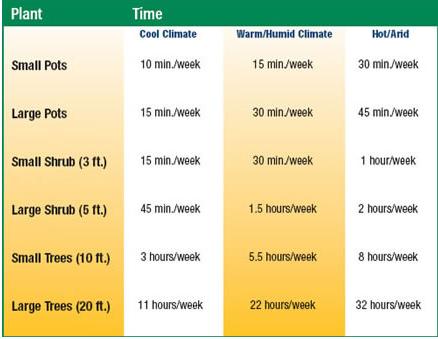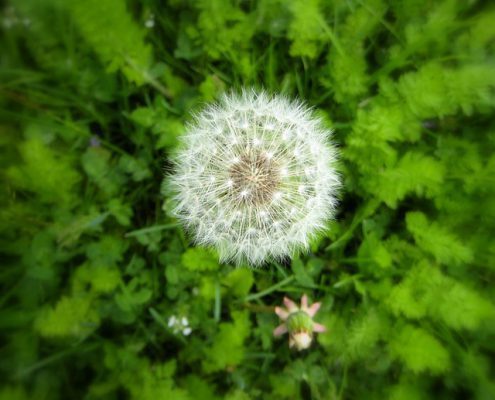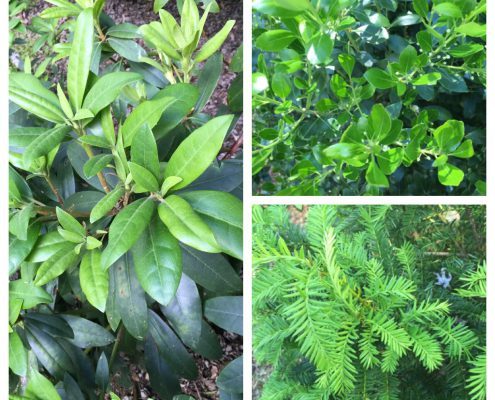The plant material has been carefully chosen for the environment (soil and light conditions) that it’s best suited and you are sitting and watching it all grow and bloom! To keep those blooms coming back year after year, follow a few landscape care tips in order to give your investment a healthy start.

A Rain Bird table guideline for how long to run your system (Note: watering times are based on using 1.0 GPH Emitters).
Landscape Care:
Deep Watering Regiment
It will depend on the size of the plant, but it’s recommended to do deep watering instead of a few minutes of hose spray. Install drip irrigation around all your shrubs and trees and connect with a multi-outlet faucet attachment. A timer attached to each outlet (use hose extensions) and attached to the irrigation hose will save time. Set the timer to water 3-4x a week in hot weather, 2-3x a week in mild weather and 1-2x a week in cooler weather. The size of the plant will determine which emitter you choose and how long it’s watering. Also, the number of plants hooked up to one hose will decrease the amount of watering flowing to each plant. Watch this video for more details about how to set up this system.
Watering consistently and deeply is the key. After the first watering, dig down beside each plant to see how far the water penetrated. If it’s not hitting the root area, plan for a longer interval next watering or continue the watering currently for another 15 minutes until the root depth has been reached. Back off the timing, if water is puddling or extremely wet. Too much water can also drown a plant and deprive it of oxygen.
This chore will be one of the most important to be concerned with after the plantings are in the ground. For the best use of water, time your watering during the early morning hours. Late evening hours tend to create mold and mildew conditions after the sun goes down.
Landscape Care: Fertilizing Regiment
We plant our shrubs, trees, grasses, perennials and annuals with soil amendments, compost/organic products and root enhancers containing the sufficient nutrients for the growth needs of the plant for the first year of getting established. The  following spring will be the next time fertilization is necessary.
following spring will be the next time fertilization is necessary.
Landscape Care: Mulching Regiment
Each spring, mulching is necessary around your plantings for a number of reasons. It retards weed growth and also holds in the moisture for your new establishing plantings. It also protects the base of shrubs and trees from weed-eaters and other equipment that might get too close to the base and damage it.
Landscape Care: Weeding Regiment
Weeds deprive new plantings of moisture. Therefore, keep the garden area weed free. Hand pulling after a good soaking rain will make it easier and more efficient after the ground is moistened. Pull from the base of the weed to ensure the inclusion of its roots.
Landscape Care: Pruning
Dead, damaged and diseased limbs and branches should be removed from the plant. Pruning is normally done in the fall to late winter or early spring while in dormancy. Throughout the year, small pruning cuts can be made but too late in the season can promote new growth, which could get damaged in the first frost. Also, certain flowering shrubs get pruned right after flowering so as not to ruin the flower buds forming for the following season. Pruning is best left to a professional or one can take training classes at the NC Arboretum to successfully learn the basics.
As the winter breaks and daylight savings time gives more hours to our days, we venture out to see what’s blooming or growing. Often times we hear that “my plant has died and has no leaves!” Some deciduous plants take longer to form leaves. The earth
warms and gives a signal to the plant. Look closely at the branches to see if new buds are forming. Break off a small branch in an inconspicuous spot to observe green growth. If so, the plant isn’t dead. It’s just prolonging coming out of dormancy. Mother Nature will wake it up when it’s time.
New growth will emerge on the tips of the plant and be tender to the touch. New growth is usually lighter in color or a varied color for that particular plant. New growth is a good sign that your plant is receiving the necessary nutrients and watering needed.
If these instructions are followed, the plantings will do well under normal circumstances. Unusual circumstances could occur when there is abnormal rainfall or a drought condition. Making adjustments in the water schedule and assuring your drainage is adequate around the beds will ensure healthy plants. Severe cold and wind can take a toll on plants and cause either winter or freeze damage.
Keep an eye on your plants and enjoy your garden!





